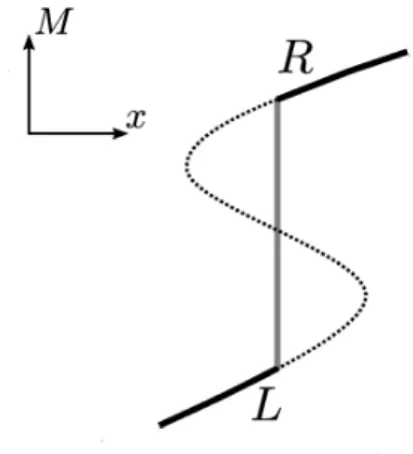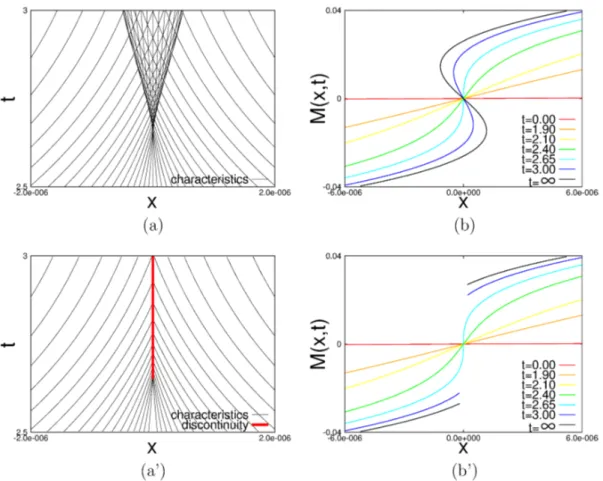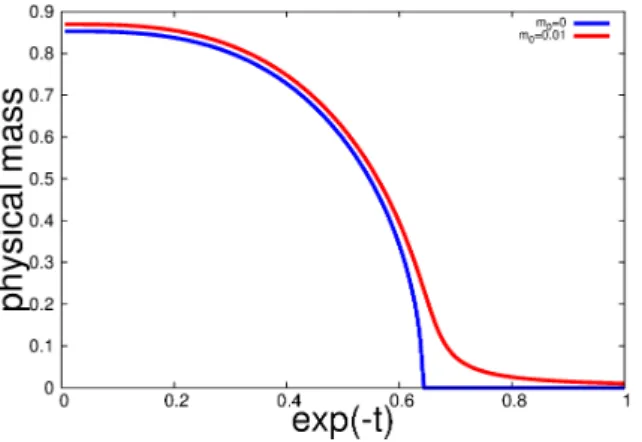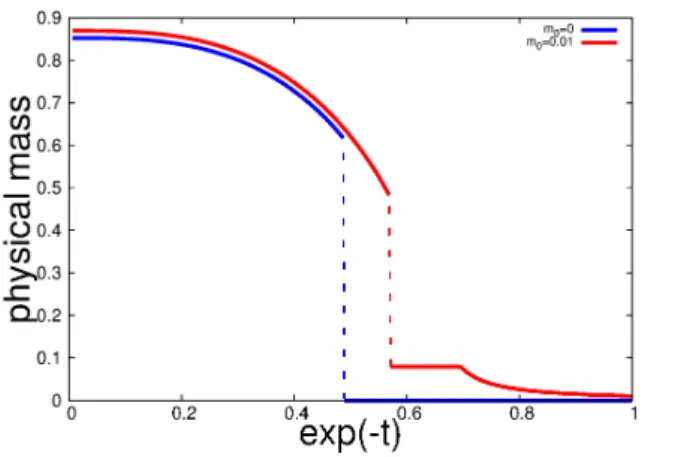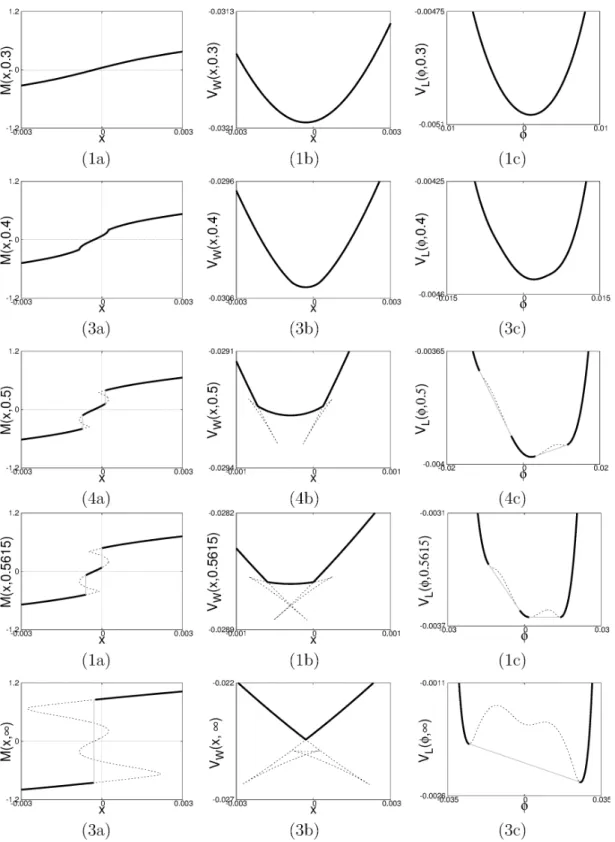Weak
Solution
of
Renormalization Group
Equation
Ken-Ichi Aoki,
Shin-Ichiro
Kumamoto and Daisuke
Sato*
$In\mathcal{S}$
titute
for
Theoretical
$Phy_{\mathcal{S}}ics$,
Kanazawa University
Abstract
In the approach ofnon-perturbative renormalization group (NPRG), the
spon-taneous chiral symmetry breaking induces a singularity in its solution, e.g., the
flow of the 4-fermi coupling constant blows up at a critical renormalization group
(RG) scale. Thus, as long as directly solving the NPRG equation as a partial
differential equation, the RG flow cannot go beyond the critical scale to obtain
in-frared quantities such as the chiral condensates. In order to treat this singularity in a mathematically rigorous way, we introduce the notion of weak solution of the
NPRGequation. The weak solution is found togive auniqueglobal solution toward theinfrared limit, and wecancalculate infraredquantitieswithout any ambiguities.
1
Introduction
The almost 100 percent ofmassis originated from spontaneouschiral symmetry breaking
$(S\chi SB)$, while
a
few percent ofmass
is given by the so-called Higgs mechanism. The$S\chi SB$ is included by the strong interaction between quarks at the low energy scale which
is described by quantum chromodynamics (QCD). Because of the strong interaction, the
perturbationtheory does not work, and
so
we need non-perturbative methods suchas
thelattice simulation and the Schwinger-Dyson (SD) approach.
In thisarticle, we usetheapproachof non-perturbative renormalization group (NPRG)
that is originatedfrom the Wilsonian idea. This approach does not have the sign problem
at finite chemical potential just like the lattice simulation, and can improve the gauge
dependence ofphysical quantities, which the SD approach suffers, in systematic
approxi-mations [1, 2].
For simplicity, we are limited to the analysis using the Nambu-Jona Lasinio (NJL)
model with a simplified discrete chiral symmetry, which is a low energy model of QCD
explaining the $S\chi SB$. Its Lagrangian is given by
$\mathcal{L}=\overline{\psi}\emptyset\psi-\frac{G_{0}}{2}(\overline{\psi}\psi)^{2}$,
(1)
where $\psi$ and $\overline{\psi}$ is
a quark field and an antiquark field, respectively Here the discrete
chiral symmetry is that the Lagrangian is invariant under the following discrete chiral
transformation:
$\psiarrow\gamma_{5}\psi, \overline{\psi}arrow-\overline{\psi}\gamma_{5}$. (2)
The chiral symmetry thus forbids the
mass
term $m\overline{\psi}\psi$ and the chiral condensates $\langle\overline{\psi}\psi\rangle.$However, when the 4-fermi coupling constant $G_{0}$ islarger than
a
critical couplingconstant,its strong coupling induces the $S\chi SB$. If using the
mean
field approximation, the criticalcoupling constant $G_{c}$ is $4\pi^{2}/\Lambda_{0}^{2}$, where $\Lambda_{0}$ is the ultraviolet cutoff scale. Note that the
mean field approximation is equivalent to the self-consistency equation limited to the
large-N leading, where $N$ is the number of quarkflavors.
Many NPRG analyses of $S\chi SB$ have been performed by introducing the
bosoniza-tion ofthe multi-fermi interactions [3-6], which is the so-called auxiliaryfield method or Hubbard-Stratonovich transformation. However the analysis without the bosonization is difficult because in theRG procedure the 4-fermi coupling constant blows up at a critical
scale as a signal of $S\chi SB[7$,8$]$. Consequently we cannot go beyond the critical scale to
obtain infrared physical quantities such
as
the chiral condensates.The goal of this article is to analyze$S\chi SB$ in theNPRG approachwithout introducing
the bosonization. Forthis goal
we
adopt themethod of weak solution [9], which has firstlybeen introduced in the NPRG approach by the authors [10]. As the NPRG equation is
given byapartial differentialequation (PDE),the weak solution satisfiesthe integral-form
(weak) equation ofthe PDE. Since the weak solution is globally defined, it can include
singularities such
as
the explosive behavior of the 4-fermi coupling constant.This article is organized
as
follows. InSect.2, webriefly explain the Wegner-Houghtonequation that is a formulation of the NPRG and the difficulty of the NPRG analysis of
$S\chi SB$ without the bosonization. In Sect3, the method of weak solution is adopted to
overcome
this difficulty. In Sect4, the baremass
of quark is introduced to define thechiral order parameters. In Sect5, the method of weak solution is applied to the first
order phase transition at finite chemical potential, and the convexity of the effective
potential given by the weak solution is discussed. Finally we summarize this article in
Sect6.
2
Non-perturbative
renormalization
group
In theNPRG approach, a central object isthe Wilsonian effective action $S_{eff}[\phi_{)}\Lambda]$ defined
by integrating the microscopic degrees of freedom $\phi_{H}$ with momentums higher than the
scale $\Lambda$
:
$\int \mathcal{D}\phi_{H}e^{-S_{0}[\phi_{L_{\rangle}}\phi_{H},\Lambda_{0}]}=e^{-S_{eff}[\phi_{L},\Lambda]}$, (3)
where $S_{0}[\phi;\Lambda_{0}]$ is a bare action with the ultraviolet cutoff scale $\Lambda_{0}$. Now we parametrize
the cutoff scale $\Lambda$ by a dimensionless scale $t$ such that
$\Lambda(t)=\Lambda_{0}e^{-t}$. (4)
The $t$-dependence of the effective action $S_{eff}[\phi;\Lambda]$ is given by a NPRG equation
as
thefollowing functional partial differential equation:
$\partial_{t}S_{eff}[\phi;t]=\beta_{WH}[\frac{\delta S_{eff}}{\delta\phi}, \frac{\delta^{2}S_{eff}}{\delta\phi^{2}};t]$ , (5)
whichis calledthe Wegner-Houghton (WH) equation [11] (seeRef. [12] forthedetailform
suchas thechiral condensatesand theeffectivequarkmass, bysettingthe bare action$S_{0}$to
the initial condition at $t=0$ and solving it as a differential equation toward the infrared
scale $(tarrow\infty)$. Of course, it cannot be solved exactly, but various non-perturbative
approximation to solve it are available.
In this article, theWHequation is applied to the NJL model (3). As anapproximation,
we restrict the full interaction space of the effective action $S_{eff}[\psi, \overline{\psi};t]$ to be the subspace
relevant to $S\chi SB$
as
follows:$S_{eff}[ \psi, \overline{\psi};t]=\int d^{4}x\{\overline{\psi}\beta\psi-V_{W}(x;t)\}$ , (6)
whereascalarfermion-bilinearfield,$x=\overline{\psi}\psi$, is introduced. The potential term
$V_{W}(x;t)$ is
called the
fermion
potentialhere, whose initial conditionis setto $V_{W}(x;t=0)=(G_{0}/2)x^{2}$according to the NJL Lagrangian(1).
In addition to the restriction ofthe interaction space, the large-N non-leading parts
of the WH equation(3) are ignored. Then, the NPRG equation for the fermion potential
in the large-N approximation is given by the following partial differential equation:
$\partial_{t}V_{W}(x;t)=\frac{\Lambda^{4}}{4\pi^{2}}\log(1+\frac{1}{\Lambda^{2}}(\partial_{x}V_{W})^{2})\equiv-F(\partial_{x}V_{W};t)$. (7)
Here the momentum cutoff A have been performed with respect to the length of four
Euclidean momentum $p_{\mu}$: $\sum_{\mu=1}^{4}p_{\mu}^{2}\leq\Lambda$. Note that the approximation used here is
equivalent to the mean field one,
Now we introduce the
mass
function, $M(x;t)=\partial_{x}V_{W}(x;t)$, to interpret the $S\chi SB$ in this framework. The value of themass
function at the origin is the coefficient of massterm $\overline{\psi}\psi$
in the effective action
as
itsname
suggests. The chiral symmetry is realized bythe invariance of the fermion potential under the chiral transformation, $xarrow-x$, given by
Eq. (2): $V(-x;t)=V(x;t)$, and then$M(-x;t)=-M(x;t)$ . TheNPRGequation(7) with
the chiral-invariant fermionpotential isalso invariant under the chiral transformation, and
thus its solution with the chiral-invariant initial condition maintain its chiral-invariant
structure at all scales. If the
mass
function is analytic, its value at the origin vanishessince the
mass
function with the chiral invariance is odd with respect to $x.$While the NPRG equationdoes not spontaneously break the chiral-invariant structure
of the fermion potential, its second derivative at the origin that is the 4-fermi coupling
constant $G(t)\equiv\partial^{2}V(x;t)/\partial x^{2}|_{x=0}$ blows up at a critical scale $t_{c}$ if its initial coupling
constant $G_{0}$islarger than the critical coupling constant $G_{c}[7,8]$. This explosive behavior is
nothing but asignal of the$S\chi SB$, and suggests that the$S\chi SB$solutionof the
mass
functionafter$t_{c}$has a finitejump atthe origin with thechiral-invariant structure. Mathematically,
sucha singular solution of the PDE cannot be authorized. However the singular solution
can be defined
as
aweak solution and predict the physicalquantities asshown in the next section.3
Method
of weak
solution
In this $section_{\}}$ we define a weak solution [9] of the mass function and show how to
mass
function,$\partial_{t}M(x;t)=-\frac{\partial}{\partial x}F(M(x;t);t)$
$=- \frac{\partial}{\partial M}F(\Lambda I;t)\cdot\frac{\partial JI}{\partial x}$
. (8)
This equation belongs to
a
class of conservation low type which includes the famousBergers’ equation without viscosity. To define the singular solution with finitejumps,
we
extend the PDE into the following weak equation:
$\int_{0}^{\infty}dt\int_{-\infty}^{\infty}dx(M\frac{\partial\varphi}{\partial t}+F\frac{\partial\varphi}{\partial x})+\int_{-\infty}^{\infty}dxM\varphi|_{t=0}=0$, (9)
where $\varphi(x;t)$ is any smooth and bounded test function. Compared to the strong
equa-tion (8), the derivative of the mass function is gotten rid off in the weak equation (9),
which can then have asingular solution with finite jumps. In general, weak solutions
are
not uniquelydetermined depending
on
the initial conditions. However the physical initialconditionis expected to give the unique weak solution.
An important fact derived from the weak equation,(9) is the Rankine-Hugoniot (RH)
condition,
$(M_{L}-M_{R})dS(t)=[F(M_{L})-F(M_{R})]dt$, (10)
where $S(t)$ is ajump position, and $M_{L}$ and $M_{R}$ are values of right and left limits of the
mass
function at $x=S(t)$. This RH condition will be used to construct the weak solution.In the rest of this section, themethod ofcharacteristics toconstruct theweak solution
is shown. We
now
considera
characteristic curve, $x=\overline{x}(t)$, and themass
functionon
it, $\overline{M}(t)=M(\overline{x};t)$, which satisfy the following coupled ordinary differential equations
(ODEs):
$\frac{d\overline{x}(t)}{dt}=\frac{\partial}{\partial M^{-}}F(\overline{M};t)$, (11)
$\frac{d\overline{M}(t)}{dt}=\frac{\partial}{\partial\overline{x}}F(\overline{M};t)=0$. (12)
Here the initial condition is given by
$\overline{x}(t=0)=x_{0}$, (13)
$\overline{M}(t=0)=\partial_{x}V_{W}(x;t)|_{x=x0,t=0}$. (14)
We
now
emphasize that $\overline{M}(t)$ is the value ofthe “local” strong solution of Eq. (8) on thecharacteristic
curve
$\overline{x}(t)$. Thus the initial value problem ofthe PDE (8) is transformed tothe partially equivalent
one
of the coupled ODEs(11), (12), although the set of (local”strong solutions is not necessarily the global solution of the original PDE
as
will beseenlater. We
can
now easily construct the set of local strong solutions by varying the valueof$x_{0}$ and solving the coupled ODEs. Moreover the value
$\overline{V}_{W}$
of the fermion potential on
$x(t)$ is obtained by solving the following ODE with Eqs. (11), (12):
$\frac{d\overline{V}_{W}(t)}{dt}=M^{-}\frac{\partial F(\overline{M};t)}{\partial M^{-}}-F(J^{-}I;t)$
Note that the PDE(7) is
a
Hamiltonian-Jacobi type equationwell-known in the analyticalmechanics, where $t,$ $x,$ $V_{W}(x;t)$, $M(x;t)$ and $F(M;t)$ correspond to the time, the
coordi-nate, the action, the momentum and the time-dependent Hamiltonian, respectively. Then
the coupled ODEs(11), (12) are nothing but the canonical equations of Hamiltonian.
The numerical solution of the characteristic curves and the setof local strong solutions
$M(x;t)$ constructed by them are shown in Fig. 2 (a), (b). The characteristic curves $\overline{x}(t)$
can be regarded
as
the contour lines of $lII(x;t)$ because the right-hand side of Eq. (12)vanishes. After $t_{c}$, the contour lines
cross
each other, and thenthe set ofthe local strongsolutions $\Lambda\ell(x;t)$ has a folding structure. Thus the set, which has the multi values, can
no
longer be the global solution of the PDE (8). On the other hand, the weak solutioncan be constructed by the patchwork of the local strong solutions, which is determined
using the RH condition (10).
Figure 1: Equal (vanishing)
area
rule.For the practicalpurpose, we here convert theRH condition to ageometric one
equiv-alent to itas follows. The totalderivatives of left and right limits of the fermion potential
$V_{W}(x;t)$ on thejump position $S(t)$ is given by
$dV_{W}^{L,R}= \frac{\partial V}{\partial x}|_{L,R}dS+\frac{\partial V}{\partialt}|_{L,R}dt$
$=M|_{L,R}dS-F|_{L,R}dt$, (16)
The difference between the left and right limits of Eq. (16) vanishes because of the RH
condition: $d(V_{W}^{L}-V_{W}^{R})=0$. Since
no
singular point doesn’t exist at the initial condition,the fermion potential is entirely continuous
even
at the jump position $S(t)$:$V_{W}^{L}=V_{W}^{R}$. (17)
Next, we integrate the set of the local strong solutions of $lII(x;t)$ as follows:
$\int_{L}^{R}Mdx=\int_{L}^{R}\frac{\partial V_{W}}{\partial x}dx$
$=V_{W}^{R}-V_{W}^{L}$
Thus the jump position
can
geometrically be determined by the equal (vanishing)area
rule (Fig. 1). In Fig. 2,
we
now
show the weak solution constructed from the local strongsolutions at $G_{0}=1.005G_{c}$ using the equal
area
rule. The jump appears at the originafter the critical scale $t_{c}$. The uniqueness of
our
weak solution is proved because of theentropy condition, which guarantees the uniqueness of weak solution when the selected
characteristic curves fill the x-t plane [9]
as
shown in Fig. 2(a’).(a) (b)
(a’) (b’)
Figure 2: (a) Characteristics. (b) Set of local strong solutions of
mass
function given bythe characteristics. (a’) Characteristics selected by the RH condition andjump
(discontinuity). (b’) Weak solution of
mass
function. The jump position obeythe equal (vanishing) area rule.
4
Bare
mass
In the previous section,
we
have obtained the $S\chi SB$ weak solution with a finite jump atthe origin. However the physical
mass
of quarkas
anorder parameter of chiral symmetrycannot be determined since the mass function at the origin is not defined. To define the
order parameter,
we
introduce the bare mass term $m_{0}\overline{\psi}\psi$, which explicitly breaks thechiral symmetry, to the Lagrangian(1). The bare
mass
term modifies the initial conditionof the PDE(8): $M(x;t=0)=G_{0}x+m_{0}$. Then, because ofthe translation invariance of
follows:
$M(x;t, m_{0})=M(x+m_{0}/G;t, m_{0}=0)$. (19)
Then the mass function at the origin is well defined because the jump appears not at the
origin but at $x=-m_{0}/G$. Thus, taking the limit $m_{0}arrow+0$ (called the chiral limit), we
can define the $t$-dependent effective mass $M_{phs}(t)$
as
theorder parameter:$M_{phys}(t)= \lim_{m0arrow+0}M(x;t, m_{0})|_{x=0}$ . (20)
Fig.3 shows the RG evolutions of the physical
masses
in the chiral limit and at thenon-zero bare
mass.1
The physicalmass
in the chiral limit shows the second order phasetransition due to the singular behavior of the
mass
function at the origin, while thephysical
mass
at $m_{0}\neq 0$ shows thecross over.
The
reader may think that theweak-solution method is not necessary if $m_{0}\neq 0$. However global methods, such
as
the weaksolution, is needed at the small bare mass compared to the physical mass since the
mass
function has the jump
near
the origin. Actually, Ref. [2] shows that the Taylor expansionto solve the PDE7 does not work at the small bare mass.
Figure 3: RG evolution of the physical masses in $m_{0}arrow 0$ and $m_{0}=$ O. The NPRG
equation given by Eq. (21) $(\mu=0, G=1.7G_{c})$ is used for evaluating the
physical
mass
to compare the result at finite chemical potential $\mu\neq 0.$5
First
order phase
transition
at
finite chemical
po-tential
Let us consider the first order phase transition at finite chemical potential $(\mu\neq 0)$ using
the weak-solution method. The first order phase transition is more non-trivial than the
second order phase transition because the RG evolution of the physical mass has a finite
jump
even
at $m_{0}\neq 0$ (as shownin Fig. 4). Moreover the non-uniqueness of weak solutionis associatedwiththefact that theeffectivepotential, which is non-convex, has the
Figure 4: RG evolutions of the physical mass at finite density.
atfinite chemical potentialisuniquely determined, andtheeffectivepotential constructed
by the weak solution is automatically “convexised” with only the
one
correct minimum.Thechemical potential$\mu$isintroduced by adding the term
$\mu\overline{\psi}\gamma_{0}\psi$
tothe Lagrangian (1).
For thesimpleNPRGequation, weusethespacialmomentumcutoff: $\sum_{i=1}^{3}p_{i}^{2}\leq\Lambda^{2}$. Then
the right-hand side of Eq. (8) changes $to^{2}$
$-F(x;t)= \frac{\Lambda^{3}}{\pi^{2}}[\sqrt{\Lambda^{2}+M^{2}}+(\mu-\sqrt{\Lambda^{2}+M^{2}})\cdot\Theta(\mu-\sqrt{\Lambda^{2}+M^{2}})]$ , (21)
where $\Theta(x)$ is the Heaviside stepfunction. The characteristic curve is consequently given
by the following ODE:
$\frac{d\overline{x}(t)}{dt_{ノ}}=-\frac{\Lambda^{3}M}{\pi^{2}\sqrt{\Lambda^{2}+M^{2}}}\Theta(\sqrt{\Lambda^{2}+M^{2}}-\mu)$ . (22)
In Fig. 5, we show thecharacteristic curves and those selected by the RH condition which
are evaluated at $m_{0}=0,$ $\mu=0.7$. and $G_{0}=1.7G_{c}$. Fig. 5 (b) shows the uniqueness of
our weak solution because the entropycondition is satisfied. Fig. 6 (a), (b) show the weak
solutions of the
mass
function and the fermion potential at $m_{0}=0.01\Lambda_{0}$. These figuresshows that intheRG procedure the two jumps simultaneouslyappear,
move
toward eachother, and finally merge into one. Thus the RG evolution of the physical mass shows the
first order phase transition as shown in Fig.4.
In the rest of this section, we discuss the convexity of the Legendre effectivepotential
constructed by the weak solution. At first, we define the free energy $W(j;t)$ by
intro-ducing the external
source
for the chiral condensates $\langle\overline{\psi}\psi\rangle$: itssource
term $j\overline{\psi}\psi$, whichis distinguished from the
mass
term, is added to the Lagrangian(1). Then the initial condition of the fermion potential is$V_{W}(x;t=0,j)=m_{0}x+ \frac{G_{0}}{2}x^{2}+jx$. (23)
lIn thereal world thebare mass has thenon-zero value given bythe Higgs mechanism.
(a) (b)
Figure 5: (a) Characteristics. (b) Characteristics selected by theRH condition andjump
(discontinuity).
Now the free energy and the chiral condensates are given by
$W(j;t)=V_{W}(x=0;t,j)$, (24)
$\phi(j;t)\equiv\langle\overline{\psi}\psi\rangle_{j}=\frac{\partial W(j;t)}{\partial j}$, (25)
respectively. Weeventually define the Legendreeffectivepotentialof the chiral condensate
as follows:
$V_{L}(\phi;t)=j\phi(j;t)-W(j;t)$, (26)
where $\partial V_{L}/\partial\phi=j$ is satisfied.
As
seen inthe previous section, because ofthe translation invariance ofthePDEwithrespect to $x$, the fermion potential at $j\neq 0$ is given by the one at $j=0$:
$V_{W}(x;t, j)=V_{W}(x+j/G_{0};t,j=0)- \frac{m_{0}j}{G_{0}}-\frac{j^{2}}{2G_{0}}$, (27)
Thus the free energy and the chiral condensates are given by the quantities at $j=0$
as
follows:
$W(j;t)=V_{W}(x=0;t,j)=V_{W}(j/G_{0};t,j=0)- \frac{m_{0}j}{G_{0}}-\frac{j^{2}}{2G_{0}}$, (28)
$\phi(j;t)=\frac{1}{G_{0}}[M(j/G_{0};t, j=0)-m_{0}-j]$ . (29)
Since
the set of local strong solutions of the mass function $M(j/G_{0};t,j=0)$ ismulti-valued, that of $\phi(j;t)$ is so. Obeying the equal area rule, the weak solution of $\phi(j;t)$ is
then constructed from its local strong solutions
as
wellas
themass
function.The set of strong solutions of $V_{L}(\phi;t)$ is not convex and has multi local minima
as
shown Fig.6(c). On the other hand, we can prove that its weak solution is the
strongsolution
as
follows. Because of the continuityof the fermionpotential(17), the freeenergy is also continuous at the jump position $j_{s}$ of the
mass
function $M(j/G_{0};t,j=0)$:$W^{L}-W^{R}=V_{W}^{L}-V_{W}^{R}=0$. (30)
Using this continuity of the free energy and Eq. (26), we obtain
$\frac{V_{L}^{L}-V_{L}^{R}}{\phi^{L}-\phi^{R}}=j_{s}$, (31)
which
means
that the line connecting the Legendre effective potential $V_{L}(\phi;t)$ at the twopositions $\phi^{L},$ $\phi^{R}$ agrees with the envelope since $\partial V_{L}/\partial\phi|_{L,R}=j_{S}$. Thus theweak solution
of the effective potential is automatically convexised and has the correct minimum which
agrees with the global minimum of the local strong solutions as shown in Fig.6.
6
Summary
In this article,
we
have introduced the weak solution to define the singular $S\chi SB$ solutionof NPRG equation that can predict physical quantities such
as
the physical quarkmass
and the chiral condensates. The weak solution satisfies the integral-form (weak) of the
PDE. Specifically
we
haveevaluated the weak solutionofthe large-NNPRG
equationforthe
mass
function whichis the first derivative of the fermionpotential with respect to thescalar bilinear-fermion field $\overline{\psi}\psi.$
We have constructed the weak solution by the method of characteristics. The set of
local strongsolutions given by the characteristics is multi-valued and thus
no
longeris theglobal solution of the PDE. The weak solution can geometrically be constructed by the
patchwork ofthe local strong solutions using the equal
area
rule, which is derived by theRankine-Hugoniot condition. The uniqueness of the weak solution has been guaranteed
by the entropy condition. Then
we
have obtained the $S\chi SB$ weak solution of themass
function with
a
finitejump at the origin.The method of weak solution has also been applied to the first order phase transition
at finite chemical potential. We have shown that in the RG procedure two jump appear
simultaneously,
move
toward each other, and finally merge into one. This RG evolutionis nothing but the first order phase transition. Finally
we
have discussed the convexityofthe Legendre effective potential of the chiral condensates which is constructed by the
weak solution of the fermion potential. The weaksolutionofthe effectivepotential, which
shows the first orderphase transition in theRG procedure, is automatically “
convexised”
with only one correct minimum, while the effective potential obtained by the mean-field
analysis has the multi local minima.
Acknowledgements
The authors greatly appreciate helpful lectures by Prof. Akitaka Matsumura who told
us
(1a) (1b) (1c) (3a) (3b) (3c) $00291$ $000365$ $\hat{tf)}$ $\overline{\eta.}$ $>^{\geq}\vee o_{-}x$ : $>^{\lrcorner}\vee\hat{\Leftrightarrow}0$ $\backslash$ $C$ $002*001$ $g$ $0001$ $000 \int_{02}$ $\theta$ 002 (1a) (1b) (1c) (3a) (3b) (3c)
Figure 6: RG evolution of physical quantities by weak solution with
non-zero
baremass
$(G_{0}=1.7G_{c}, m_{0}=0.01\Lambda_{0}, \mu=0.7, t=0.3,0.4,0.5,0.5615, \infty)$. (a) Mass
function. (b) Fermion potential. (c) Legendre effective potential. The thick
solid lines denote the weak solution, and the dashed linesdenotethelocalstrong
solutions dropped by the equal
area
rule. The thin solid line in (c) denotes theReferences
[1] K.-I. Aoki, K. Takagi, H. Terao, and M. Tomoyose, Prog.Theor.Phys. 103,
815
(2000), hep-th/0002038.
[2] K.-I. Aoki and D. Sato, PTEP 2013, 043B04 (2013),
1212.0063.
[3] K.-I. Aoki, (1996), hep-ph/9706204.
[4] K.-I. Aoki, Prog.Theor.Phys.Suppl. 131, 129 (1998).
[5] K.-I. Aoki, K. Morikawa, J.-I. Sumi, H. Terao, and M. Tomoyose, Phys.Rev. D61,
045008
(2000), hep-th/9908043.[6] H. Gies and C. Wetterich, Phys.Rev. D65, 065001 (2002), hep-th/0107221.
[7] K.-I. Aoki, Int.J.Mod.Phys. B14,
1249
(2000).[8] J. Braun, J.Phys. G39,
033001
(2012),1108.4449.
[9] L. C. Evans, Partial
Differential
Equations, 2nd Edition (Amer MathematicalSoci-ety, 2010).
[10] K.-I. Aoki, S.-I. Kumamoto, and D. Sato, in preparation (2014).
[11] F. J. Wegner and A. Houghton, Phys.Rev. A8,
